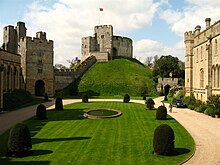
Sir William Waller JP was an English soldier and politician, who commanded Parliamentarian armies during the First English Civil War. Elected MP for Andover to the Long Parliament in 1640, Waller relinquished his military positions under the Self-denying Ordinance in 1645. Although deeply religious and a devout Puritan, he belonged to the moderate Presbyterian faction, who opposed the involvement of the New Model Army in politics post 1646. As a result, he was one of the Eleven Members excluded by the army in July 1647, then again by Pride's Purge in December 1648 for refusing to support the Trial of Charles I, and his subsequent execution in January 1649.

The Battle of Alton, of the First English Civil War, took place on 13 December 1643 in the town of Alton, Hampshire, England. There, Parliamentary forces serving under Sir William Waller led a successful surprise attack on a winter garrison of Royalist infantry and cavalry serving under the Earl of Crawford. The Battle of Alton was the first decisive defeat of Sir Ralph Hopton, leader of Royalist forces in the south, and the event had a significant psychological effect on him as commander. More important to Hopton was the loss of men, however, as he was already short-handed in much-needed infantry. The successful Parliamentarians were able, after their victory, to attack and successfully besiege Arundel, a larger and more formidable Royalist outpost to the south-east of Alton.

The First English Civil War took place in England and Wales from 1642 to 1646. It is part of the 1639 to 1653 Wars of the Three Kingdoms, which also include the Bishops' Wars, the Irish Confederate Wars, the Second English Civil War, the Anglo-Scottish war (1650–1652) and the Cromwellian conquest of Ireland. Historians calculate some 15% to 20% of all adult males in England and Wales served in the military between 1639 and 1653, while around 4% of the total population died from war-related cause, versus 2.23% in World War I. These figures illustrate the impact of the conflict on society in general, and the bitterness it engendered.

The Battle of Cheriton of 29 March 1644 was an important Parliamentarian victory during the First English Civil War. Sir William Waller's "Army of the Southern Association" defeated a Royalist force jointly commanded by the Earl of Forth and Sir Ralph Hopton. Defeat ended Royalist hopes of retaking South East England and forced them onto the defensive for the rest of 1644.

Sir Richard Browne, c. 1602 to 24 September 1669, was a merchant and MP from London who became a Major general in the Parliamentarian army during the Wars of the Three Kingdoms. A moderate Presbyterian, after victory in the First English Civil War Browne supported a negotiated settlement in which Charles I retained his throne. As a result, he fell out with radicals such as Oliver Cromwell, and was excluded from Parliament by Pride's Purge in December 1648.

The siege of Basing House near Basingstoke in Hampshire, was a Parliamentarian victory late in the First English Civil War. Whereas the title of the event may suggest a single siege, there were in fact three major engagements. John Paulet, 5th Marquess of Winchester owned the House and as a committed Royalist garrisoned it in support of King Charles I, as it commanded the road from London to the west through Salisbury.

Joseph Bampfield (1622–1685) was an English soldier and spy, who served with the Royalist army in the Wars of the Three Kingdoms, then became an intelligence agent for The Protectorate. Banished from England after the 1660 Stuart Restoration, he moved to the Dutch Republic and joined the Dutch States Army when the Second Anglo-Dutch War began in 1665. As a result he was convicted of treason by Parliament and never returned home.

William Ogle, 1st Viscount Ogle was an English soldier from Northumberland who settled in Hampshire and was Member of Parliament for Winchester from 1640 to 1643. He served in a number of wars and was Royalist governor of Winchester from 1643 to 1645.

Sir Edward Ford, 22 April 1605 to 3 September 1670, was a member of the West Sussex gentry and inventor, who fought for the Royalists in the Wars of the Three Kingdoms. In his "History of the Rebellion", Clarendon judged that while 'a man of honesty and courage', Ford lacked experience of war and was an ineffectual soldier. However, he proved a reliable and trustworthy agent during negotiations between Charles I and Parliament in the period leading up to the 1648 Second English Civil War.

The siege of Chichester was a victory by Parliamentarian forces led by Colonel William Waller over a small Royalist garrison. The siege was one of the key events in the First English Civil War by Waller to secure southern England and declare it for Parliament. The siege lasted five days and ended with surrender by the Royalists. Despite the Royalist surrender, Waller's troops proceeded to sack and desecrate Chichester Cathedral.

The siege of Plymouth took place during the First English Civil War, when Royalist forces besieged Plymouth, in Devon, held by a Parliamentary garrison.

Sir Humphrey Bennet (1605–1667) was a Hampshire landowner who fought for the Royalists in the First English Civil War, in which he rose to the command of a cavalry brigade. He went into exile in 1645, returned home in 1646 and was active in a number of Royalist conspiracies during The Protectorate.

The Storming of Farnham Castle occurred on 1 December 1642, during the early stages of the First English Civil War, when a Parliamentarian force attacked the Royalist garrison at Farnham Castle in Surrey. Sir John Denham had taken possession of the castle for the Royalists in mid-November, but after the Royalists had been turned back from London at the Battle of Turnham Green, a Parliamentarian force under the command of Sir William Waller approached the castle. After Denham refused to surrender, Waller's forces successfully stormed the castle. They captured it in under three hours, mostly due to the unwillingness of the Royalist troops to fight. This allowed the Parliamentarians to get close enough to breach the gates, after which the garrison surrendered.

Wardour Castle in Wiltshire was besieged twice during the First English Civil War; once in May 1643, and then again between November 1643 and March 1644. During the first siege, a Parliamentarian force of around 1,300 men led by Sir Edward Hungerford attacked the castle, which was the home of Thomas Arundell, 2nd Baron Arundell of Wardour, a prominent Catholic and Royalist. Arundell was absent, fighting for King Charles at the time of the attack, and the defence was led by his wife, Lady Blanche Arundell, in command of 25 soldiers. The siege was started on 2 May, and lasted for a week before the Parliamentarians forced Lady Arundell to surrender on 8 May. The Parliamentarians garrisoned the castle with 75 men, led by Colonel Edmund Ludlow.

The Battle of Bramber Bridge was a minor skirmish that took place on 13 December 1643, during the First English Civil War. A Royalist detachment from Arundel attempted to secure the bridge over the River Adur at Bramber in West Sussex, but found a Parliamentarian force already in possession.

The siege of Exeter (1642) or First Siege of Exeter took place during the First English Civil War from late December 1642 to early January 1643 when Royalists led by Sir Ralph Hopton attempted to capture the port of Exeter from the Parliamentarians.

The London Trained Bands (LTBs) were a part-time military force in the City of London from 1559 until they were reconstituted as conventional Militia regiments in 1794. They were periodically embodied for home defence, for example in the army mustered at Tilbury during the Armada Campaign of 1588. They saw a great deal of active service during the English Civil War, including the First and Second Battles of Newbury, and the battles of Alton, Cheriton, Cropredy Bridge and Lostwithiel. Throughout their history they were used to suppress civil disorder and insurrection around the capital.
The Kent Trained Bands were a part-time militia recruited from Kent in South East England, first organised in 1558. They were periodically embodied for home defence and internal security, including the Spanish Armada campaign in 1588, and saw active service during the Wars of the Three Kingdoms. They fell into abeyance in the early 18th century.
The Westminster Trained Bands were a part-time military force established in 1572, recruited from residents of the City of Westminster. As part of the larger London Trained Bands, they were periodically embodied for home defence, such as during the 1588 Spanish Armada campaign. Although service was technically restricted to London, the Trained Bands formed a major portion of the Parliamentarian army in the early years of the First English Civil War. After the New Model Army was established in April 1645, they returned to their primary function of providing security for the palaces of Westminster and Whitehall. Following the 1660 Stuart Restoration, the City of London Militia Act 1662 brought them under the direct control of the Crown, with the Trained Bands becoming part of the British Army.
The Somerset Trained Bands were a part-time military force in the county of Somerset in South West England from 1558 until they were reconstituted as the Somerset Militia in 1662. They were periodically embodied for home defence, for example in the army mustered at Tilbury during the Armada Campaign of 1588. They fought of the Battle of Newburn in the Second Bishops' War and their units saw considerable active service for both sides during the English Civil War.




















